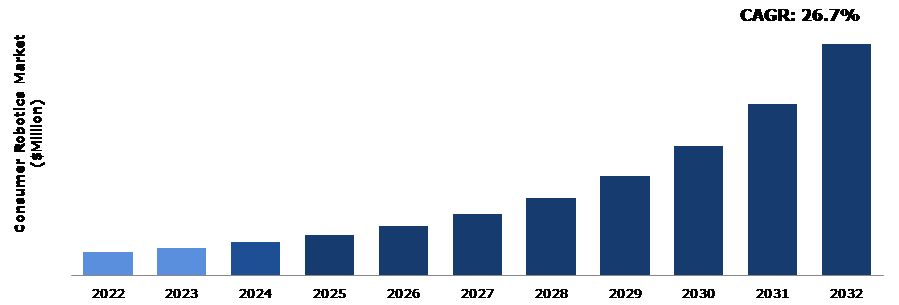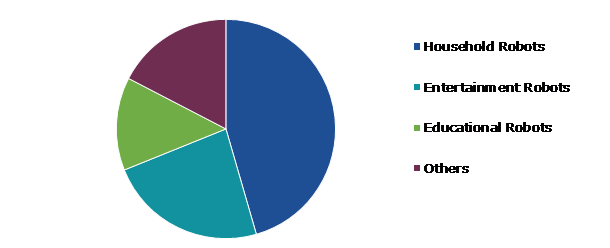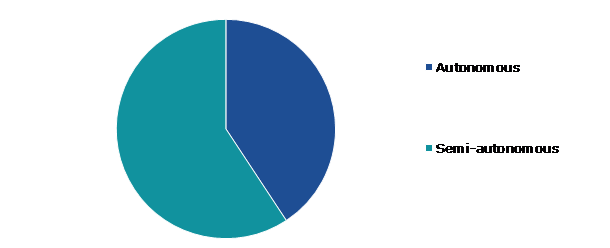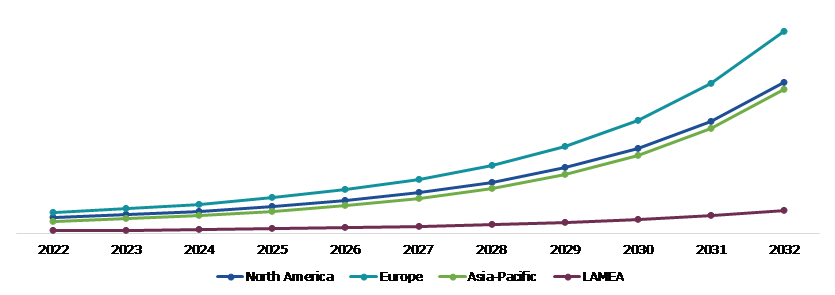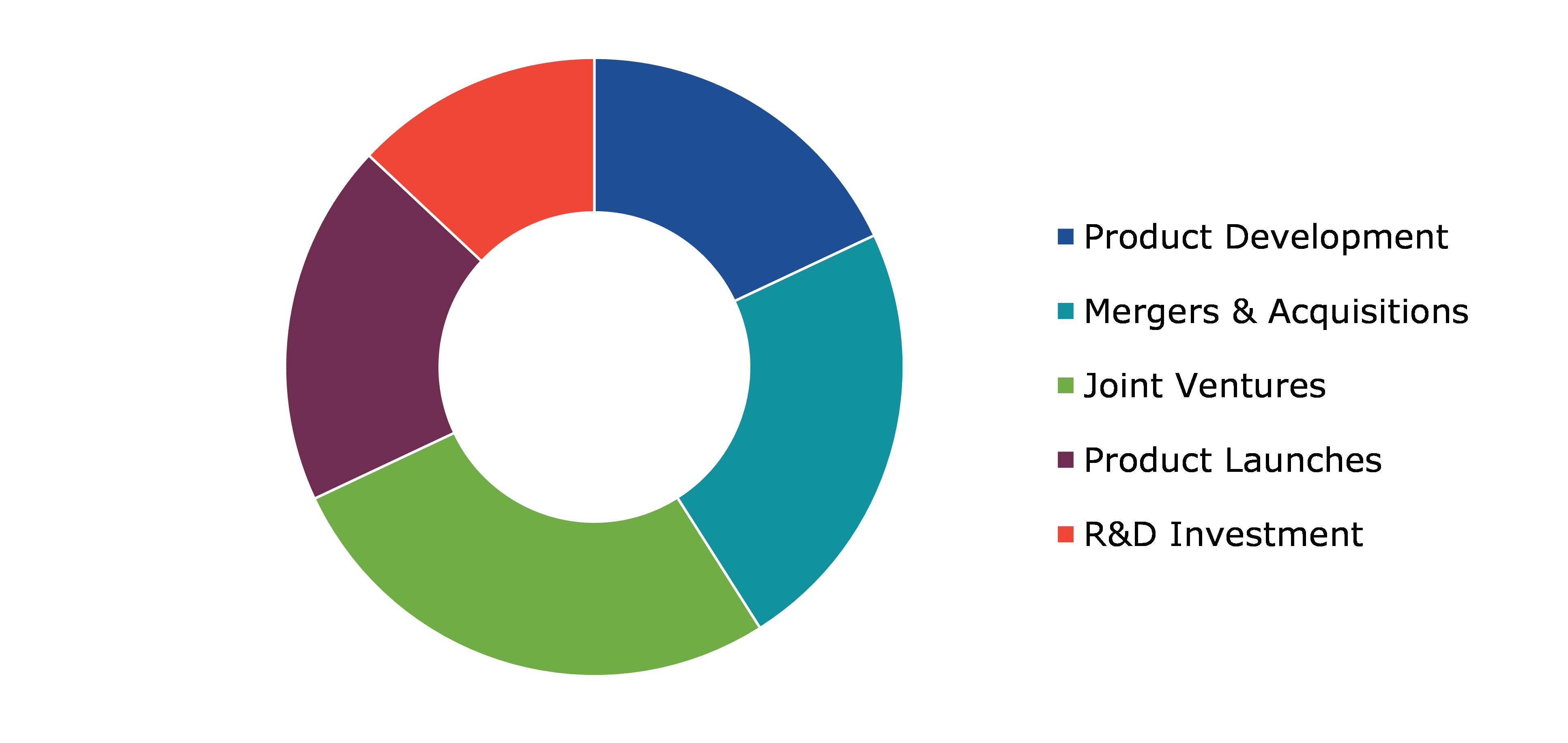Consumer Robotics Market Report
RA09193
Consumer Robotics Market by Application (Household Robots, Entertainment Robots, Educational Robots, and Others), Type (Autonomous and Semi-autonomous), and Region (North America, Europe, Asia-Pacific, and LAMEA): Global Opportunity Analysis and Industry Forecast, 2023-2032
Consumer Robotics Overview
Consumer robotics, a branch of robotics focused on personal and domestic applications, has rapidly evolved, offering a variety of small, portable, and user-friendly devices. Ranging from vacuum cleaners to lawn mowers, these robots simplify household chores, showcasing the technological developments made in engineering. The increasing integration of robotics in everyday life reflects not just convenience but a potential paradigm shift, empowering individuals to assign everyday tasks to machines.
Consumer robotics, with its potential to transform daily routines, offers greater efficiency and productivity. The automation of routine chores not only simplifies life but also opens avenues for personal growth and exploration. As these robots continue to advance, they promise to enhance human potential, enabling the accomplishment of tasks that were previously deemed challenging or unattainable. The integration of consumer robotics into daily lives represents a compelling glimpse into a future where human-machine collaboration enhances people’s capabilities and reshapes the way they approach various tasks and challenges.
Global Consumer Robotics Market Analysis
The global consumer robotics market size was $5,980.90 million in 2022 and is predicted to grow with a CAGR of 26.7%, by generating a revenue of $59,535.10 million by 2032.
Source: Research Dive Analysis
COVID-19 Impact on the Global Consumer Robotics Market
During the COVID-19 pandemic, the global consumer robotics market experienced a notable positive impact. The demand for robots surged as the pandemic highlighted the limitations of traditional surface disinfection methods. Standard disinfectants faced challenges as their effectiveness depended on human factors, leading to variations in manual cleaning and disinfection practices. This prompted businesses and organizations to explore alternative solutions, leading to a rise in the production and promotion of UV-disinfection robots. These robots gained traction as a convenient and efficient means to instantly disinfect rooms and surfaces comprehensively. Hospital management, in particular, found them appealing due to the automation they offered, along with perceived cost savings by reducing the need for manual cleaning manpower. The use of UV-C as a final disinfection step after manual cleaning and disinfection not only automated the process but also provided an additional layer of hygiene, reducing cross-transmission and the risk of diseases associated with healthcare environments.
The post-pandemic period has led to a promising resurgence in the consumer robotics industry, marked by several positive developments. As economies worldwide recover and industries regain their position, the demand for these robots is experiencing a gradual but steady rebound. Consumer robotics are proving to be necessary in a diverse range of applications, including healthcare, household work, entertainment, and others, which is playing a key role in driving industry growth.
Rising Demand for Consumer Robotics in Smart Homes to Drive the Market Growth
The increasing trend of smart homes is expected to be a major factor driving the demand for consumer robotics. As smart home ecosystems become increasingly prevalent, consumer robots are becoming increasingly popular to serve as indispensable personal assistants, in-home caregivers, and even pet sitters. A global megatrend reflects the rising consumer inclination towards products that genuinely free up time, prompting a willingness to invest in solutions that claim to streamline daily tasks. The substantial drop in prices of these robots, as a result of continuous technological progress by manufacturers worldwide, is expected to further boost the demand for these versatile machines. The remarkable attributes of consumer robots, characterized by increased precision, efficiency, and reliability in executing specified tasks, are key factors driving the growth of the consumer robotics market. The positive impact of social interaction with robots has been observed, resulting in a reduction in negative emotional and behavioral symptoms in individuals. This not only enhances mood but also elevates the overall quality of care. The global consumer robotics market is on a growth trajectory due to increasing demand for autonomous and semi-autonomous robotic technology. This growth is supported by the widespread use of handheld computing devices and the global increase in internet penetration.
High Initial Cost of Consumer Robots to Restrain the Market Growth
The initial cost of purchasing consumer robots is one of the major factors projected to hamper the market revenue growth. The substantial upfront expenses associated with purchasing these advanced technologies can discourage potential consumers, resulting in limited market penetration, especially in price-sensitive markets. The financial burden of the initial investment poses a challenge for individuals and households, impacting the overall accessibility of consumer robots and slowing down their integration into everyday life. Addressing this cost barrier is crucial for unlocking the full potential of consumer robotics and ensuring broader acceptance among diverse consumer segments. Strategies such as cost reduction initiatives, financing options, or innovative pricing models may be essential in overcoming this obstacle and fostering greater adoption of consumer robots across various markets.
Technological Advancements and Integration of AI in Consumer Robotics to Drive Excellent Opportunities
Consumer robotics heavily leverage artificial intelligence (AI), machine learning (ML), and deep learning (DL) technologies, marking significant advancements in the field. AI, representing a machine's ability to perform tasks that typically require human intellect, plays a pivotal role in providing robots with capabilities like speech recognition, natural language understanding, and decision-making. This enables robots to detect and interact with their surroundings, make informed judgments, and execute complex tasks. In sophisticated robotic systems, AI is employed to create robots that can autonomously perceive, reason, and act in intricate environments. Machine learning comes into play to enable robots to learn from their experiences, enhancing their performance progressively over time. Deep learning, a subset of machine learning, addresses specific challenges, particularly in areas like image and speech recognition. By integrating these technologies, advanced consumer robotics systems are designed to undertake complex tasks previously considered impossible. In consumer services, robotics contributes to activities such as cleaning, food delivery, and customer service. AI and ML algorithms are instrumental in enabling robots to interact effectively with humans, understand their needs, and adapt to their preferences, thereby enhancing the overall consumer experience.
Global Consumer Robotics Market Share, by Application, 2022
Source: Research Dive Analysis
The household robots sub-segment accounted for the highest market share in 2022. As technological advancements continue to progress at a rapid pace, robots are increasingly becoming integral to daily lives. Among the various types of robots emerging, domestic robots, also known as personal service or companion robots, have found a place in both homes and workplaces. Tailored to assist with household tasks, these robots contribute to chores such as cleaning, laundry, and providing care for the elderly or disabled. One notable example of consumer-centric robotics is the vacuum robots product line, dedicated to residential use. These robot vacuums cater to consumers seeking a convenient solution for maintaining clean homes without the need for manual labor. Equipped with state-of-the-art navigation systems, these devices can detect obstacles like furniture legs, ensuring smooth operation without getting stuck. This technological innovation not only streamlines household maintenance but also offers users with peace of mind, knowing that their living spaces can remain clean even when unattended.
Global Consumer Robotics Market Share, by Type, 2022
Source: Research Dive Analysis
The semi-autonomous sub-segment accounted for the highest market share in 2022. Semi-autonomous consumer robots represent a significant evolution in robotics technology, blending user control with automated functionalities. These robots are designed to operate with a certain degree of independence, capable of performing tasks without constant human intervention. While users maintain a level of oversight and control, these robots leverage advanced sensors and algorithms to navigate and execute predefined functions. This semi-autonomous nature allows for versatility in various applications, from household chores to assistance in specific tasks.
Global Consumer robotics Market Size & Forecast, by Region, 2022-2032 ($Million)
Source: Research Dive Analysis
The Europe consumer robotics market generated the highest revenue in 2022. The consumer robotics market in Europe is experiencing significant growth, driven by an increasing demand for consumer robots in the region. European individuals are increasingly incorporating robots into their daily lives, particularly for household tasks. The demand is particularly high for robots designed to assist with various domestic chores. In addition, a significant number of consumer robotics manufacturers are based in Europe. For example, a report published by the International Federation of Robots in 2020 revealed that Europe recorded the highest number of startups, with 94 new ventures in the field of service robotics. This trend reflects the robust expansion and adoption of consumer robotics within the European market.
Competitive Scenario in the Global Consumer Robotics Market
Product launch, investment, and acquisition are common strategies followed by major market players. For instance, in August 2023, Dreame US, a fast-rising technological firm and top maker of home cleaning appliances, announced the release of their new Robotic Mower product line. This is Dreame US 's second robotics expansion, following the successful introduction of their smart food delivery robots and robotic pool cleaners.
Source: Research Dive Analysis
Some of the leading consumer robotics market players are Blue Frog Robotics, Inc., 3D Robotics Inc, Neato Robotics, Inc., Bossa Nova Robotics Inc., Honda Motors Co Ltd., iRobot Corporation, Hasbro Inc., Samsung Electronics Co. Ltd., LG Electronics Inc., and Google Inc.
| Aspect | Particulars |
| Historical Market Estimations | 2020-2021 |
| Base Year for Market Estimation | 2022 |
| Forecast Timeline for Market Projection | 2023-2032 |
| Geographical Scope | North America, Europe, Asia-Pacific, and LAMEA |
| Segmentation by Type |
|
|
Segmentation by Application
|
|
| Key Companies Profiled |
|
Q1. What is the size of the global consumer robotics market?
A. The size of the global consumer robotics market was $5,980.90 million in 2022 and is projected to reach $59,535.10 million by 2032.
Q2. Which are the major companies in the consumer robotics market?
A. Neato Robotics, Bossa Nova Robotics, and Honda Motors Company Ltd. are some of the key players in the global consumer robotics market.
Q3. Which region, among others, possesses greater investment opportunities in the future?
A. Asia-Pacific possesses great investment opportunities for investors in the future.
Q4. What will be the growth rate of the Asia-Pacific consumer robotics market?
A. The Asia-Pacific consumer robotics market is anticipated to grow at 28.7% CAGR during the forecast period.
Q5. What are the strategies opted by the leading players in this market?
A. Product launches and investment are the two key strategies opted by the operating companies in this market.
Q6. Which companies are investing more on R&D practices?
A. LG Electronics Inc., Samsung Electronics Co. Ltd., and iRobot Corporation are the companies investing more on R&D activities for developing new products and technologies.
1. Research Methodology
1.1. Desk Research
1.2. Real time insights and validation
1.3. Forecast model
1.4. Assumptions and forecast parameters
1.5. Market size estimation
1.5.1. Top-down approach
1.5.2. Bottom-up approach
2. Report Scope
2.1. Market definition
2.2. Key objectives of the study
2.3. Market segmentation
3. Executive Summary
4. Market Overview
4.1. Introduction
4.2. Growth impact forces
4.2.1. Drivers
4.2.2. Restraints
4.2.3. Opportunities
4.3. Market value chain analysis
4.3.1. List of raw material suppliers
4.3.2. List of manufacturers
4.3.3. List of distributors
4.4. Innovation & sustainability matrices
4.4.1. Technology matrix
4.4.2. Regulatory matrix
4.5. Porter’s five forces analysis
4.5.1. Bargaining power of suppliers
4.5.2. Bargaining power of consumers
4.5.3. Threat of substitutes
4.5.4. Threat of new entrants
4.5.5. Competitive Rivalry Intensity
4.6. PESTLE analysis
4.6.1. Political
4.6.2. Economical
4.6.3. Social
4.6.4. Technological
4.6.5. Legal
4.6.6. Environmental
4.7. Impact of COVID-19 on Consumer Robotics market
4.7.1. Pre-covid market scenario
4.7.2. Post-covid market scenario
5. Consumer Robotics Market Analysis, by Type
5.1. Overview
5.2. Autonomous
5.2.1. Definition, key trends, growth factors, and opportunities
5.2.2. Market size analysis, by region, 2022-2032
5.2.3. Market share analysis, by country, 2022-2032
5.3. Semi-autonomous
5.3.1. Definition, key trends, growth factors, and opportunities
5.3.2. Market size analysis, by region, 2022-2032
5.3.3. Market share analysis, by country, 2022-2032
5.4. Research Dive Exclusive Insights
5.4.1. Market attractiveness
5.4.2. Competition heatmap
6. Consumer Robotics Market Analysis, by Application
6.1. Overview
6.2. Household Robots
6.2.1. Definition, key trends, growth factors, and opportunities
6.2.2. Market size analysis, by region, 2022-2032
6.2.3. Market share analysis, by country, 2022-2032
6.3. Entertainment Robots
6.3.1. Definition, key trends, growth factors, and opportunities
6.3.2. Market size analysis, by region, 2022-2032
6.3.3. Market share analysis, by country, 2022-2032
6.4. Educational Robots
6.4.1. Definition, key trends, growth factors, and opportunities
6.4.2. Market size analysis, by region, 2022-2032
6.4.3. Market share analysis, by country, 2022-2032
6.5. Others
6.5.1. Definition, key trends, growth factors, and opportunities
6.5.2. Market size analysis, by region, 2022-2032
6.5.3. Market share analysis, by country, 2022-2032
6.6. Research Dive Exclusive Insights
6.6.1. Market attractiveness
6.6.2. Competition heatmap
7. Consumer Robotics Market, by Region
7.1. North America
7.1.1. U.S.
7.1.1.1. Market size analysis, by Type, 2022-2032
7.1.1.2. Market size analysis, by Application, 2022-2032
7.1.2. Canada
7.1.2.1. Market size analysis, by Type, 2022-2032
7.1.2.2. Market size analysis, by Application, 2022-2032
7.1.3. Mexico
7.1.3.1. Market size analysis, by Type, 2022-2032
7.1.3.2. Market size analysis, by Application, 2022-2032
7.1.4. Research Dive Exclusive Insights
7.1.4.1. Market attractiveness
7.1.4.2. Competition heatmap
7.2. Europe
7.2.1. Germany
7.2.1.1. Market size analysis, by Type, 2022-2032
7.2.1.2. Market size analysis, by Application, 2022-2032
7.2.2. UK
7.2.2.1. Market size analysis, by Type, 2022-2032
7.2.2.2. Market size analysis, by Application, 2022-2032
7.2.3. France
7.2.3.1. Market size analysis, by Type, 2022-2032
7.2.3.2. Market size analysis, by Application, 2022-2032
7.2.4. Spain
7.2.4.1. Market size analysis, by Type, 2022-2032
7.2.4.2. Market size analysis, by Application, 2022-2032
7.2.5. Italy
7.2.5.1. Market size analysis, by Type, 2022-2032
7.2.5.2. Market size analysis, by Application, 2022-2032
7.2.6. Rest of Europe
7.2.6.1. Market size analysis, by Type, 2022-2032
7.2.6.2. Market size analysis, by Application, 2022-2032
7.2.7. Research Dive Exclusive Insights
7.2.7.1. Market attractiveness
7.2.7.2. Competition heatmap
7.3. Asia-Pacific
7.3.1. China
7.3.1.1. Market size analysis, by Type, 2022-2032
7.3.1.2. Market size analysis, by Application, 2022-2032
7.3.2. Japan
7.3.2.1. Market size analysis, by Type, 2022-2032
7.3.2.2. Market size analysis, by Application, 2022-2032
7.3.3. India
7.3.3.1. Market size analysis, by Type, 2022-2032
7.3.3.2. Market size analysis, by Application, 2022-2032
7.3.4. Australia
7.3.4.1. Market size analysis, by Type, 2022-2032
7.3.4.2. Market size analysis, by Application, 2022-2032
7.3.5. South Korea
7.3.5.1. Market size analysis, by Type, 2022-2032
7.3.5.2. Market size analysis, by Application, 2022-2032
7.3.6. Rest of Asia-Pacific
7.3.6.1. Market size analysis, by Type, 2022-2032
7.3.6.2. Market size analysis, by Application, 2022-2032
7.3.7. Research Dive Exclusive Insights
7.3.7.1. Market attractiveness
7.3.7.2. Competition heatmap
7.4. LAMEA
7.4.1. Brazil
7.4.1.1. Market size analysis, by Type, 2022-2032
7.4.1.2. Market size analysis, by Application, 2022-2032
7.4.2. UAE
7.4.2.1. Market size analysis, by Type, 2022-2032
7.4.2.2. Market size analysis, by Application, 2022-2032
7.4.3. Saudi Arabia
7.4.3.1. Market size analysis, by Type, 2022-2032
7.4.3.2. Market size analysis, by Application, 2022-2032
7.4.4. South Africa
7.4.4.1. Market size analysis, by Type, 2022-2032
7.4.4.2. Market size analysis, by Application, 2022-2032
7.4.5. Rest of LAMEA
7.4.5.1. Market size analysis, by Type, 2022-2032
7.4.5.2. Market size analysis, by Application, 2022-2032
7.4.6. Research Dive Exclusive Insights
7.4.6.1. Market attractiveness
7.4.6.2. Competition heatmap
8. Competitive Landscape
8.1. Top winning strategies, 2022
8.1.1. By strategy
8.1.2. By year
8.2. Strategic overview
8.3. Market share analysis, 2022
9. Company Profiles
9.1. Blue Frog Robotics
9.1.1. Overview
9.1.2. Business segments
9.1.3. Product portfolio
9.1.4. Financial performance
9.1.5. Recent developments
9.1.6. SWOT analysis
9.2. iRobot Corporation
9.2.1. Overview
9.2.2. Business segments
9.2.3. Product portfolio
9.2.4. Financial performance
9.2.5. Recent developments
9.2.6. SWOT analysis
9.3. 3D Robotics
9.3.1. Overview
9.3.2. Business segments
9.3.3. Product portfolio
9.3.4. Financial performance
9.3.5. Recent developments
9.3.6. SWOT analysis
9.4. Neato Robotics
9.4.1. Overview
9.4.2. Business segments
9.4.3. Product portfolio
9.4.4. Financial performance
9.4.5. Recent developments
9.4.6. SWOT analysis
9.5. Bossa Nova Robotics
9.5.1. Overview
9.5.2. Business segments
9.5.3. Product portfolio
9.5.4. Financial performance
9.5.5. Recent developments
9.5.6. SWOT analysis
9.6. Honda Motors Company Ltd.
9.6.1. Overview
9.6.2. Business segments
9.6.3. Product portfolio
9.6.4. Financial performance
9.6.5. Recent developments
9.6.6. SWOT analysis
9.7. Google Inc.
9.7.1. Overview
9.7.2. Business segments
9.7.3. Product portfolio
9.7.4. Financial performance
9.7.5. Recent developments
9.7.6. SWOT analysis
9.8. Hasbro Inc.
9.8.1. Overview
9.8.2. Business segments
9.8.3. Product portfolio
9.8.4. Financial performance
9.8.5. Recent developments
9.8.6. SWOT analysis
9.9. Samsung Electronics Co. Ltd.
9.9.1. Overview
9.9.2. Business segments
9.9.3. Product portfolio
9.9.4. Financial performance
9.9.5. Recent developments
9.9.6. SWOT analysis
9.10. LG Electronics Inc.
9.10.1. Overview
9.10.2. Business segments
9.10.3. Product portfolio
9.10.4. Financial performance
9.10.5. Recent developments
9.10.6. SWOT analysis
Personalize this research
- Triangulate with your own data
- Request your format and definition
- Get a deeper dive on a specific application, geography, customer or competitor
- + 1-888-961-4454 Toll - Free
- support@researchdive.com

